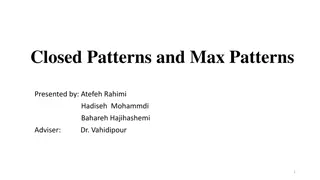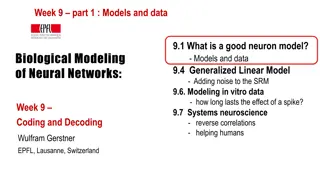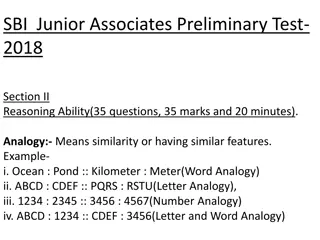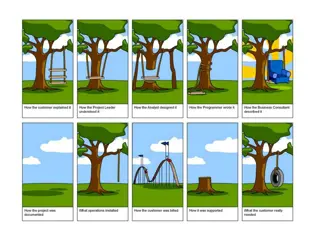
Navigating Business Dynamics: Decoding Trends & Patterns
In our ever-evolving business landscape, staying ahead by identifying trends and patterns is essential for survival. Explore the difference between them, their impact, and strategies for leveraging them effectively to anticipate change and seize opportunities.
Download Presentation

Please find below an Image/Link to download the presentation.
The content on the website is provided AS IS for your information and personal use only. It may not be sold, licensed, or shared on other websites without obtaining consent from the author. If you encounter any issues during the download, it is possible that the publisher has removed the file from their server.
You are allowed to download the files provided on this website for personal or commercial use, subject to the condition that they are used lawfully. All files are the property of their respective owners.
The content on the website is provided AS IS for your information and personal use only. It may not be sold, licensed, or shared on other websites without obtaining consent from the author.
E N D
Presentation Transcript
Title: "Decoding Trends and Patterns: Navigating Business Dynamics in an Ever- Evolving Landscape" Presenter : Dr. Vincent Bizimana Position :Head of Department of Business Management Texila American University-Zambia
Introduction In our fast-paced and interconnected world, businesses are constantly faced with the challenge of staying ahead of the curve. Understanding the trends and patterns that shape our industry is not just advantageous it's essential for survival. Trends and patterns influence every aspect of our operations, from strategic planning to day-to-day decision-making. We'll discuss: the difference between trends and patterns, examine their impact on business outcomes, and explore strategies for identifying, analyzing, and leveraging them to our advantage.
1. Importance of Identifying Trends and Patterns in Business Strategic Planning Competitive Advantage Risk Management Innovation: Customer Insights Resource Allocation
Cont. Hence , identifying trends and patterns in business is not just about staying current it's about staying ahead. By leveraging these insights, businesses can anticipate change, seize opportunities, and navigate the complexities of an ever-evolving marketplace with confidence and agility.
DIFFERENCE BETWEEN TRENDS AND PATTERNS Trends: Patterns: Directional Movement: Trends represent the general direction in which a variable or phenomenon is moving over time. They indicate the long-term trajectory of a market, industry, or consumer behavior. Longevity: Trends typically persist over an extended period, ranging from months to years. They reflect enduring shifts in preferences, attitudes, or market dynamics. Impact: Trends have a broad impact, influencing multiple aspects of business operations, such as product development, marketing strategies, and consumer demand. Examples of trends include the adoption of renewable energy, the rise of e-commerce, or the growing demand for plant-based food products. Repetitive Structures: Patterns refer to recurring structures or behaviors that occur predictably over time. They can manifest as regular fluctuations, cycles, or sequences in data or market behavior. Short to Medium-Term: Patterns typically unfold over shorter time frames compared to trends. (daily, weekly, monthly, ..) Predictability: Patterns exhibit a degree of predictability, allowing businesses to anticipate future occurrences based on historical data and analysis. Examples of patterns include seasonal sales fluctuations, weekly consumer spending patterns, or the cyclical nature of economic recessions and recoveries.
The Impact of Trends vs. Patterns on Business Trends and patterns both play significant roles in influencing business decisions and outcomes, but they operate in slightly different ways. Trends: In business, trends can encompass a wide range of factors, including consumer preferences, market demand, technological advancements, and economic conditions. Identifying and understanding trends is crucial for businesses to stay competitive and relevant. For example, businesses may need to adapt their products, services, or marketing strategies to align with emerging trends in their industry. Patterns: Patterns are recurring themes or behaviors that can be observed over time. They often arise from the analysis of data and can provide valuable insights into past and present circumstances. Patterns in business data can include seasonal fluctuations in sales, customer buying behaviors, or operational inefficiencies. Recognizing patterns allows businesses to anticipate future events, optimize processes, and make informed decisions.
The impact of trends and patterns on business can be summarized as follows: Strategic Planning: Both trends and patterns inform strategic planning efforts. Understanding long-term trends helps businesses anticipate future market conditions and adapt their strategies accordingly. Analyzing patterns enables businesses to optimize operations, improve efficiency, and capitalize on opportunities. Decision Making: Trends and patterns guide decision-making processes across various functions within a business. For example, marketing decisions may be influenced by consumer trends and purchasing patterns, while operational decisions may be based on production or supply chain patterns.
Cont. Innovation: Trends often drive innovation by creating demand for new products, services, or business models. By identifying emerging trends, businesses can innovate proactively to meet evolving customer needs and preferences. Patterns, on the other hand, can highlight areas where innovation is needed to address recurring issues or inefficiencies. Risk Management: Both trends and patterns are important considerations in risk management. Anticipating future trends allows businesses to proactively mitigate risks and seize opportunities. Analyzing patterns helps businesses identify potential risks and vulnerabilities, enabling them to implement preventive measures or contingency plans.
Cont. Competitive Advantage: Businesses that effectively monitor and respond to trends and patterns can gain a competitive advantage in the marketplace. By staying ahead of emerging trends and leveraging insights from data patterns, businesses can differentiate themselves, attract customers, and drive growth.
IDENTIFYING AND ANALYZING TRENDS Here's a structured approach to identifying and analyzing trends: Market Research: Conduct thorough market research to understand the current landscape of your industry. This includes analyzing industry reports, market studies, and competitor analysis. Look for emerging technologies, consumer behaviors, and shifts in market demand. Customer Feedback: Engage with your customers through surveys, focus groups, and social media channels to gather insights into their preferences, needs, and pain points. Pay attention to their feedback regarding existing products or services, as well as their expectations for future offerings. Data Analysis: Utilize data analytics tools to analyze large datasets for patterns and trends. This can include sales data, website analytics, social media metrics, and customer demographics. Look for correlations, seasonal fluctuations, and emerging patterns that could indicate changing consumer behavior or market dynamics.
Cont. Industry Experts and Thought Leaders: Stay informed about industry trends by following industry experts, thought leaders, and influencers. Attend conferences, webinars, and networking events to learn about the latest developments and insights from leading professionals in your field. Technology Monitoring: Keep an eye on technological advancements that could disrupt your industry or create new opportunities. Monitor developments in areas such as artificial intelligence, blockchain, Internet of Things (IoT), and renewable energy, and consider how these technologies could impact your business. Global Events and Socioeconomic Factors: Pay attention to global events, socioeconomic trends, and regulatory changes that could influence your industry. Factors such as political instability, environmental concerns, and demographic shifts can have far-reaching effects on consumer behavior and market dynamics.
Cont. 1. Experimentation and Innovation: Foster a culture of experimentation and innovation within your organization. Encourage employees to explore new ideas, test hypotheses, and prototype innovative solutions. Experimentation allows you to quickly adapt to changing trends and customer preferences. 2. Continuous Monitoring and Adaptation: Trends are constantly evolving, so it's essential to continuously monitor the market and adapt your strategies accordingly. Set up systems for regular trend analysis and review, and be prepared to pivot your business model or offerings in response to new developments.
RECOGNIZING PATTERNS FOR STRATEGIC ADVANTAGE Here are key steps to recognize patterns effectively: Data Collection and Integration: Gather data from various sources within your organization, including sales records, customer feedback, operational metrics, and market research. Integrate these datasets to gain a comprehensive understanding of your business ecosystem. Data Analysis and Visualization: Utilize data analysis techniques, such as statistical analysis, machine learning algorithms, and data visualization tools, to identify patterns within your data. Visualizing data through charts, graphs, and dashboards can help uncover trends, correlations, and anomalies that may not be apparent through raw data alone.
Cont. Identify Key Metrics: Determine the key performance indicators (KPIs) and metrics that are most relevant to your business objectives. These could include sales growth rates, customer acquisition costs, retention rates, or operational efficiency metrics. Tracking these metrics over time allows you to identify patterns and trends that impact your strategic goals. Segmentation and Targeting: Segment your customer base and market into distinct groups based on demographics, behavior, or other relevant criteria. Analyze patterns within each segment to identify unique preferences, needs, and buying behaviors. This enables you to tailor your marketing strategies and product offerings to better meet the needs of specific customer segments.
Cont. Competitive Analysis: Analyze patterns in your competitors' behavior, market positioning, and performance metrics to identify strengths, weaknesses, and opportunities for differentiation. Look for patterns in their product releases, pricing strategies, marketing campaigns, and customer engagement efforts. This allows you to anticipate competitive threats and identify areas where you can gain a strategic advantage. Market Trends and External Factors: Monitor external factors, such as economic indicators, regulatory changes, technological advancements, and consumer trends, that may impact your industry. Identify patterns in market trends and anticipate shifts in consumer behavior or market dynamics. This enables you to adapt your strategies proactively and capitalize on emerging opportunities.
Cont. Predictive Analytics and Forecasting: Use historical data and trend analysis to develop predictive models and forecasts for future outcomes. By recognizing patterns in past performance and market dynamics, you can make more accurate predictions about future trends, demand fluctuations, and business opportunities. This allows you to allocate resources effectively and make informed strategic decisions. Continuous Monitoring and Adaptation: Recognize that patterns are dynamic and may evolve over time. Continuously monitor key metrics, market trends, and competitive dynamics to stay informed about changes in your business environment. Be prepared to adapt your strategies and tactics accordingly to maintain your strategic advantage.
Anticipating Future Trends and Patterns Here's how businesses can anticipate future trends and patterns effectively: Market Research and Analysis: Conduct comprehensive market research to understand current industry trends, consumer preferences, and market dynamics. Analyze industry reports, market studies, and competitor strategies to identify emerging patterns and anticipate future developments. Consumer Insights: Gather insights from your target audience through surveys, focus groups, and social listening tools. Pay attention to shifts in consumer behavior, preferences, and purchasing habits. Identify emerging trends and evolving needs that may shape future market demand.
Cont. Technology Monitoring: Keep abreast of technological advancements and innovations that have the potential to disrupt your industry or create new opportunities. Monitor developments in areas such as artificial intelligence, blockchain, Internet of Things (IoT), and renewable energy. Anticipate how these technologies may impact your business and industry landscape. Industry Experts and Thought Leaders: Stay informed about industry trends and predictions by following industry experts, thought leaders, and influencers. Attend conferences, webinars, and networking events to learn about the latest developments and insights from leading professionals in your field.
Economic and Socioeconomic Trends: Monitor economic indicators, geopolitical events, and socioeconomic trends that may impact your business environment. Pay attention to factors such as GDP growth, inflation rates, employment trends, and regulatory changes. Anticipate how these external factors may influence consumer behavior, market demand, and industry dynamics. Scenario Planning: Develop scenario-based planning exercises to anticipate various future scenarios and their potential implications for your business. Consider best-case, worst-case, and most likely scenarios based on different combinations of trends and external factors. Identify strategic responses and contingency plans to mitigate risks and capitalize on opportunities.
Cont. Data Analytics and Predictive Modeling: Leverage data analytics and predictive modeling techniques to forecast future trends and patterns based on historical data and current trends. Use statistical analysis, machine learning algorithms, and predictive analytics tools to identify correlations, extrapolate trends, and make informed predictions about future outcomes. Innovation: Foster a culture of innovation within your organization to adapt to changing market dynamics and anticipate future trends. Encourage employees to explore new ideas.
Lessons Learned from Companies That Failed to Anticipate Examples of Businesses That Successfully Adapted to Emerging Trends: 1. Netflix: 1. Kodak: Adaptation: Netflix started as a DVD rental service but successfully transitioned to a streaming platform, anticipating the shift in consumer behavior towards online streaming. Failure to Anticipate: Kodak, a pioneer in the photography industry, failed to anticipate the shift from film to digital photography. Missed Opportunities: Despite inventing the digital camera in the 1970s, Kodak hesitated to embrace digital technology, fearing it would cannibalize its film business. Strategy: Netflix invested heavily in original content production, leveraging data analytics to personalize recommendations and enhance user experience. Result: Kodak filed for bankruptcy in 2012, underscoring the importance of innovation and adaptation in the face of disruptive technological changes. Result: Today, Netflix is a leading global entertainment company with millions of subscribers worldwide, demonstrating the importance of anticipating and capitalizing on emerging trends in the media industry.
STRATEGIES FOR IMPLEMENTATION Steps to Integrate Trend and Pattern Analysis into Business Processes: Define Objectives: Clearly define the objectives of trend and pattern analysis, such as identifying market opportunities, mitigating risks, or improving operational efficiency. Data Collection: Collect relevant data from various sources, including internal systems, market research reports, customer feedback, and industry publications. Data Analysis: Utilize data analysis techniques, such as statistical analysis, data mining, and machine learning, to identify trends, patterns, and correlations within the data.
Cont. Integration with Decision-Making: Integrate trend and pattern analysis into decision-making processes across different functional areas of the organization, such as marketing, product development, operations, and finance. Automation and Technology: Invest in automation tools and technology platforms that can streamline data collection, analysis, and reporting processes, enabling real-time insights and faster decision-making. Cross-Functional Collaboration: Foster collaboration between different departments and teams to share insights and leverage collective expertise in interpreting trends and patterns. Feedback Loop: Establish a feedback loop to continuously evaluate the effectiveness of trend and pattern analysis efforts and make adjustments as needed to improve outcomes.
Building a Culture of Innovation and Adaptability: Leadership Support: Secure buy-in and support from senior leadership to foster a culture of innovation and adaptability throughout the organization. Encourage Experimentation: Encourage employees to experiment with new ideas, technologies, and approaches to solving problems. Create a safe environment where failure is viewed as a learning opportunity. Reward Creativity and Risk-Taking: Recognize and reward employees who demonstrate creativity, initiative, and a willingness to take calculated risks to drive innovation.
Cont. 1. Training and Development: Invest in training and development programs to enhance employees' skills in areas such as critical thinking, problem-solving, and creativity. 2. Cross-Pollination of Ideas: Facilitate cross-functional collaboration and knowledge-sharing to facilitate the exchange of ideas and perspectives across different parts of the organization. 3. Embrace Diversity: Embrace diversity and inclusion to foster a culture of innovation that values different perspectives and experiences. 4. Lead by Example: Leadership should lead by example by demonstrating a willingness to embrace change, experiment with new ideas, and adapt to evolving market conditions.
Conclusion In conclusion, by recognizing the importance of trends and patterns, implementing effective strategies, and fostering a culture of innovation and adaptability, businesses can thrive in today's dynamic business landscape and shape the future of their industries.






















